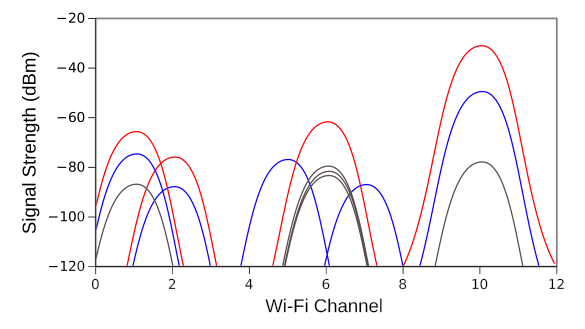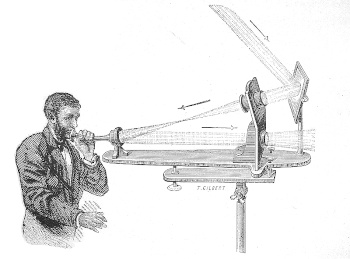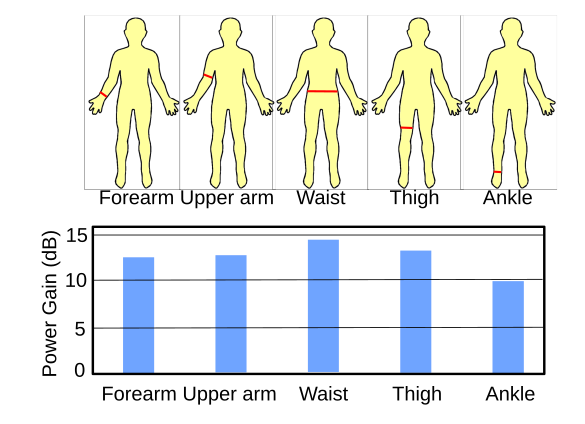Optical Communication
March 13, 2023
Long before
software feature creep, there was the start of the incessant creep up the
radio frequency spectrum.
AM radio broadcasting, at a center
frequency of 1
MHz, was the first useful
consumer application of radio frequencies. One MHz, which is just a hundred times higher than
audio frequencies, paved the way for
FM radio at a center frequency of 100 MHz,
UHF television with a top frequency of 887 MHz, and the first
cellphones, also at
800 MHz.
Presently,
5G cellphone frequencies are commonly at 1.7-4.7
GHz, with provision for higher frequencies of 24-47 GHz. A frequency of 47 GHz is five
orders of magnitude higher than that of the lowest frequency AM radio station.
Radio communications congestion is not totally mitigated by this migration to higher and higher frequencies. As an example, many
consumer electronic devices use
Wi-Fi for
network connection. When there are multiple
transmitters on a
channels,
collisions between competing
signals result in lower speeds.

This is a snapshot of the local lowband WiFi spectrum at my house. These are just the devices that transmit an SSID. There are active IOT devices not present here. The four most powerful devices are in my house, and the others are neighbors' devices, including one printer. (Data collected using the Linux Wi-Fi scanner, LinSSID, and graphed using a combination of Gnumeric and Inkscape.Click for larger image.)
We are rushing towards a limit on radio frequency communication. The topmost radio frequency band on the
electromagnetic spectrum is the
Extremely high frequency band (EHF) that ends at 300 GHz. Above that, we have
light in the form of the
far infrared (FIR). Light can be used for
line-of-sight communications; and, surprisingly, this was first done in 1880 by
Alexander Graham Bell (1847-1922).
Bell and his
assistant,
Charles Sumner Tainter (1854-1940),
invented the
photophone, a device that enabled
telephone communication on a
beam of
focused sunlight (see image). In this device,
sound waves incident on a
flexible mirror changed its
shape from
convex, which
scatters light, to
concave, which focuses light. A distant
receiver converts the
modulated light back to sound. This was first accomplished by the
photoacoustic effect, and later by a
selenium photodetector wired into an
electric telephone receiver.

Etching of a photophone transmitter. Solar radiation from the top of the image is focused onto the flexible mirror at the left.
(Wikimedia Commons image from the Biblioteca de la Universidad de Sevilla. Click for larger image.)
Today, optical communication is facilitated by the availability of
light-emitting diodes (LEDs) and
semiconductor photodetectors. One early use of these was in short-range
data communication by
infrared light in the 850-900
nanometer range. This is still used in many devices, such as the ubiquitous
remote control. The
Infrared Data Association (IrDA) established standards for such communication starting in 1994, although many remote controls now use more reliable radio frequencies.
The migration of room lighting to LEDs has given an opportunity to
piggy-back free-space optical communication functionality inexpensively into room
light fixtures. Such
technology would reduce Wi-Fi congestion in
office buildings, even if implemented only for
download data, since there's generally more than a 10:1
ratio between the quantity of downloaded and
uploaded data. The current
snapshot of this ratio for my
Linux desktop computer is 15.89. The
infrastructure for visible light communication is everywhere. Outside our homes, there is LED lighting in
streetlights and
automobiles. Any computing device with a
camera, such as
tablet computers and
smartphones, are already capable of being configured as optical receivers.
A
Chinese research team has published a recent
open access review article about high-speed visible light communication based on micro-LEDs[1-2] The high
data rate of visible light communication will help to enable the next-generation
6G networks. Importantly, light communication can be done without a
license, and it's both
immune to electromagnetic interference and it does not produce high levels of electromagnetic interference.[2] This makes it a good communications medium for locations sensitive to electromagnetic interference, such as
nuclear power plants,
airports,
hospitals, and
underground mines.[2] As addressed in the review article, micro light-emitting diodes (μLEDs) are an excellent choice for for high-speed visible light communication, since they have a high
modulation bandwidth.[1] The μLEDs will function also as high-speed photodetectors.[2]
Powering a desktop or tablet computer to receive, and possibly send, optical data is not a problem. Powering
wearable electronic devices is more of a problem, since bulky
battery packs are undesirable. Fortunately, wearable devices usually need just a small amount of power, since they lack large displays. Visible light communication devices do leak low intensity radio frequency signals during transmission, and a research team with members from the
University of Massachusetts Amherst (Amherst, Massachusetts) and the
Delft University of Technology (Delft, The Netherlands) have invented a low-cost method to
harvest this energy by using the
human body as an
antenna.[3-5] Their research paper received the
Best Paper Award from the
Association for Computing Machinery’s 2022 Conference on Embedded Networked Sensor Systems.[4]
In their
experiments, they found that surrounding objects act as antennas that enhance the radio frequency reception of an
inductance coil used as an antenna.[3] A variety of objects act as antennas, but the human body gave the best response, up to ten times more than an isolated coil.[3-4] They decided that the best configuration was a coil of
copper wire worn as a
bracelet on the upper
forearm, a device they call a
Bracelet+, although
ring,
belt,
anklet and
necklace coils had good response.[4]

power gain of radio frequency reception for inductance coils arranged on the human body. (Created using Inkscape. Human body outline from Wikimedia Commons. Data from fig. 13 of ref. 3.[3] Click for larger image.)
Experiment showed that
microwatts of power could be harvested, which is enough to power simple
body sensors such as
blood glucose monitors, since these have a low sampling rate.[3-4] The authors note that their energy harvester costs less than fifty
cents.[4]
References:
- Tingwei Lu, Xiangshu Lin, Wenan Guo, Chang-Ching Tu, Shibiao Liu, Chun-Jung Lin, Zhong Chen, Hao-Chung Kuo and Tingzhu Wu, "High-speed visible light communication based on micro-LED: A technology with wide applications in next generation communication," Opto-Electronic Science, vol 1, no. 12 (December 29, 2022), article no. 220020, doi: 10.29026/oes.2022.220020. This is an open access article with a PDF file here.
- High-speed visible light communication based on micro-LED: A technology with wide applications in next generation communication, Press Release from Compuscript Ltd, January 6, 2023.
- Minhao Cui, Qing Wang, and Jie Xiong, "Next-generation Wireless Technology May Leverage the Human Body for Energy, Association for Computing Machinery, SenSys '22, November 6–9, 2022, Boston, Massachusetts. A PDF file can be found here.
- Next-generation Wireless Technology May Leverage the Human Body for Energy, University of Massachusetts Amherst Press Release, January 4, 2023.
- My son-in-law introduced me to the idea of holding an automobile remote alongside your face to get greater range. Some experiments to confirm this would be interesting.
Linked Keywords: Computer software; feature creep; radio frequency; electromagnetic spectrum; AM radio broadcasting; frequency; MHz; consumer; audio frequency; FM broadcasting; FM radio; UHF television broadcasting; mobile phone; cellphone; cellular frequencies; 800 MHz; 5G cellphone frequencies; GHz; orders of magnitude; radio communications; network congestion; consumer electronic device; Wi-Fi; wireless LAN; network connection; transmitter; channel (communications); collision domain; collision; signal (electronics); carrier-sense multiple access with collision avoidance; lower speeds; snapshot; lowband WiFi; service set (802.11 network); SSID; Internet of things; IOT device; power (physics); powerful; house; neighborhood; neighbor; printer (computing); data; Linux; radio scanner; LinSSID; chart; graph; Gnumeric; Inkscape; extremely high frequency band (EHF); light; far infrared (FIR); line-of-sight propagation; line-of-sight communication; Alexander Graham Bell (1847-1922); technician; assistant; Charles Sumner Tainter (1854-1940); invention; invented; photophone; telephone; light beam; focus (optics); focused; sunlight; sound wave; deflection (engineering); flexible; mirror; geometry; shape; convex; light scattering; concave; receiver (radio); modulation; modulated; photoacoustic effect; selenium; photodetector; electronic circuit; wired; electric telephone receiver; etching; Solar radiation; Biblioteca de la Universidad de Sevilla; light-emitting diodes (LEDs); semiconductor device; semiconductor photodetector; data; communication; infrared light; nanometer; remote control; Infrared Data Association (IrDA); piggy-back; free-space optical communication; function (engineering); functionality; light fixture; technology; office building; download; ratio; upload; Linux; desktop computer; infrastructure; streetlight; car; automobile; digital camera; tablet computer; smartphone; Chinese; research; open access; review article; bit rate; data rate; 6G network; spectrum management; license; immunity; immune; nuclear power plant; airport; hospital; subterranea (geography); underground; mining; mine; quadrature amplitude modulation; modulation bandwidth; wearable electronic device; battery pack; University of Massachusetts Amherst (Amherst, Massachusetts); Delft University of Technology (Delft, The Netherlands); energy harvesting; human body; antenna (radio); Best Paper Award; Association for Computing Machinery; 2022 Conference on Embedded Networked Sensor Systems; inductance coil; copper wire; bracelet; forearm; ring (jewelry); belt (clothing); anklet; necklace; antenna gain; microwatt; body area network; body sensor; blood glucose monitor; cent.